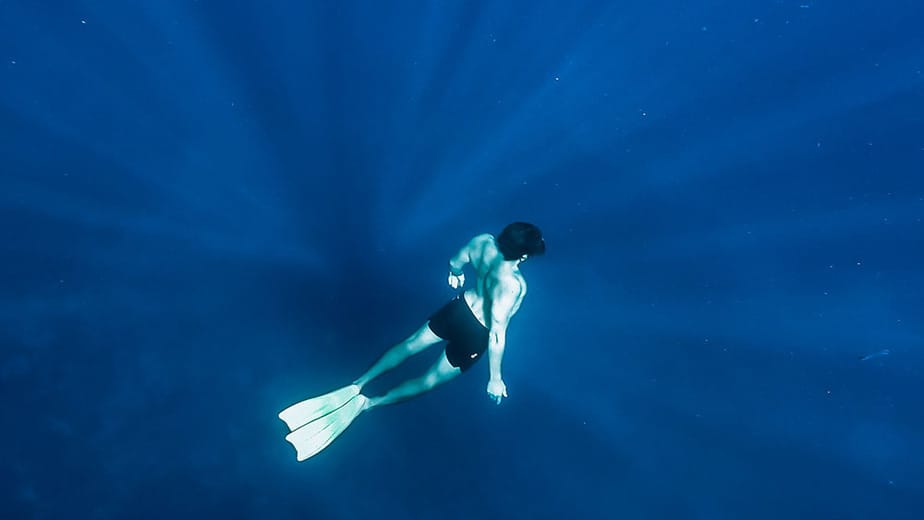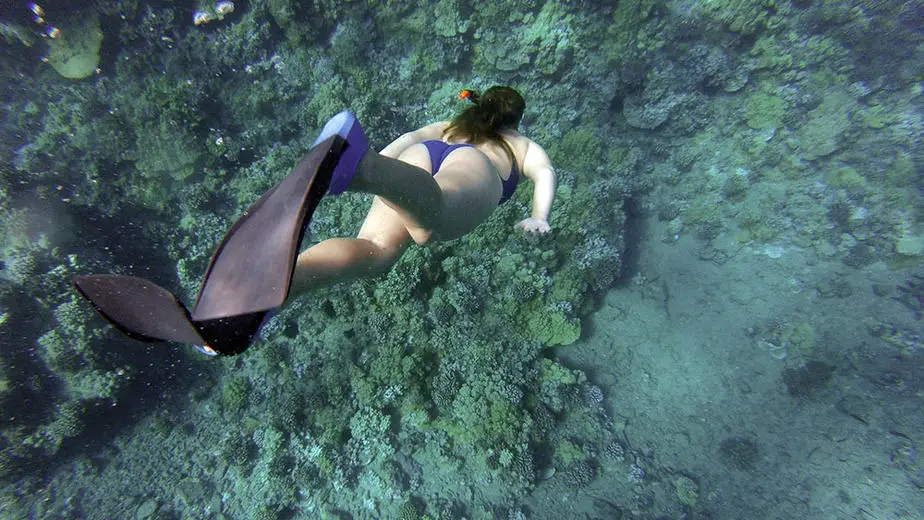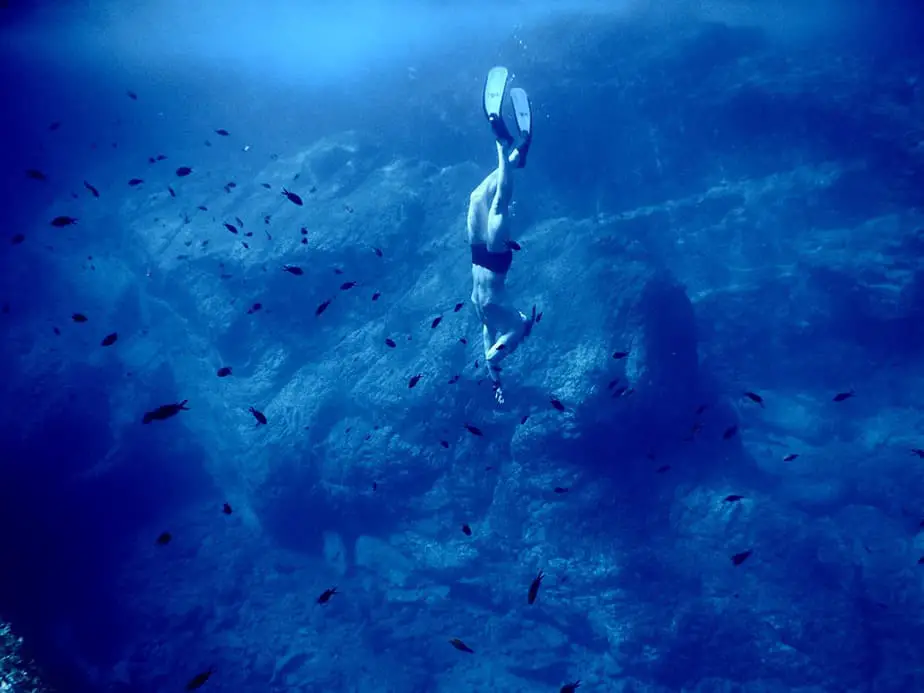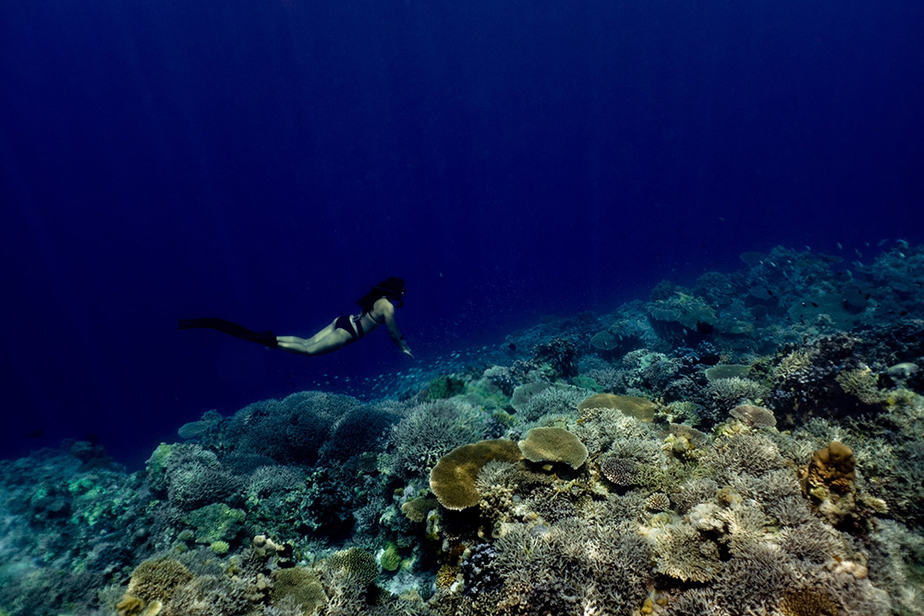When holding your breath, at some point you will feel the urge to breathe. This signal can appear in various ways, but the most obvious way is through diaphragm contractions. Freediving contractions can throw off a lot of beginners who fear that they are about to black out. In this guide, we will look at the causes of freediving contractions and how to manage them so that they don’t negatively affect our freediving.
My First Encounter with Freediving Contractions
The first time I encountered a freediving contraction, like many beginners I panicked and quickly resurfaced. From that point on, my diaphragm contractions became a mental block for me; each time I felt them, I felt a sense of impending dread that I was about to black out and had to resurface.
Then I saw a professional freediver practicing static apnea in a pool. During the first part of his breath-hold, his body stayed perfectly still. After a few minutes, I noticed his upper body occasionally twitch, indicating that the contractions had started. “He will soon surface”, I thought to myself. Looks like even the pros can’t avoid it, but he sure held off for a long time. To my surprise, this would only be around the halfway point of his breath-hold.
He kept his head underwater while his contractions became more frequent until it seemed like his entire torso was convulsing violently. “My god, he’s going to drown!” I worriedly thought from afar. But he had a buddy nearby who was monitoring him, and he didn’t seem worried at all so clearly this was something he’s used to. The freediver ended up with a breath-hold of over 7-minutes.
My mind was blown. The violent convulsing scared me, but clearly this man knew his limits and showed me what was possible with sufficient training. With renewed vigor, I continued my breath-hold training with the goal of overcoming my fear of freediving contractions and staying underwater for much longer.
What are Diaphragm Contractions When Freediving?
Diaphragm contractions are the double-edged sword of every breath-hold. Contractions are one of the indicators that your body is starved of oxygen. Unfortunately, for most people, the start of the first contraction is the beginning of the struggle, or the contraction phase of a breath-hold.
Contractions help increase the blood flow from the heart. Each contraction means a momentary increase of blood flow to the brain. For a body that is deprived of oxygen, this is technically a good thing.
What Causes a Diaphragm Contraction?
The natural urge to breathe when we deprive our body of oxygen comes from rising levels of carbon dioxide in the blood. As our lungs convert more oxygen into carbon dioxide without exhaling, the body will realize something is wrong and stimulates itself to breathe. That is what diaphragm contractions are.
A diaphragm contraction can be very subtle, almost like a flutter, or it can be so severe it basically shifts one’s entire upper body. Some freedivers say they barely feel their diaphragm contractions, and others feel it more violently and very early on.
For me, my contractions start approximately after one minute and never eases off. In fact, it only gets more and more intense and. To an outsider, it may look like I am writhing in pain after being punched in the stomach. Some freedivers experience them in waves where it can temporarily stop for a minute or so before resuming. For me, once I get them, they just keep coming until I resurface.
In addition to CO2 build-up, the increasing water pressure can also lead to getting diaphragm contractions early. Many freedivers start to feel the contractions during their descent which can cause them to lose focus because they haven’t even reached the halfway point of their dive.
Stress is another major factor that can lead to contractions, as can cold water. If you decide to freedive in cold water and something happened earlier to you that is stressing you out, then expect to feel a very strong diaphragm contraction during your breath-hold.
Strong contractions can sometimes lead to a lung injury, so we recommend warming up carefully for each dive, increasing depth at a comfortable pace before you try to dive to new depths.
When Do Contractions Start During a Breath-Hold?

The first part of the breath-hold will feel relaxing and comfortable because the contractions haven’t started yet. When you still have plenty of oxygen to work with and barely any CO2 buildup has occurred yet, you will be able to achieve mindfulness more easily. Take this time to enjoy the calm and tranquility as you continue diving down. This peace won’t last, and in short order you will be fighting a tough mental battle, but for now just relax.
The middle part of the breath-hold begins when you start to feel the urge to breathe, which is signaled by your diaphragm contracting. When your stomach starts to involuntarily twitch and squeeze, you are experiencing a contraction. Sometimes the contractions will occur gently and slowly. Other times they will be more pronounced, and may cause a beginner freediver to panic.
As you approach your limit, the contractions will only worsen. After all, it’s your body signalling to you that you are about to blackout. Beginners may find it difficult to determine when exactly they should resurface and when they should endure their contractions. Unfortunately, this is something that can only be determined with experience, so it’s best to practice with a dive buddy in case you black out.
Additional Factors that Cause Freediving Contractions
Sometimes contractions can occur within 30 seconds of a dive. Sometimes they can take up to three minutes into the breath-hold to occur. There are various factors which can influence this, including what type of breath-hold you are doing and how well you have trained for the dive. But there are also many minor factors that can contribute stronger contractions.
For example, compare an experienced freediver who is doing static apnea with their face submerged underwater to an absolute beginner. The advanced diver has done this hundreds of times before, and they are likely able to stave off their contractions for a long time with their well-trained body and mental fortitude.
Now imagine if conditions are not so favorable. Imagine trying to do the same static apnea hold with strong currents. Perhaps it’s the first dive of the year and you’re out of practice. Perhaps you’re feeling anxious and you didn’t sleep well the night before, and on top of that you didn’t eat that well. Maybe the weather is cold and windy on the surface. These factors could make your contractions occur much faster.
Your surroundings as well as physical and mental preparation can drastically affect your diaphragm contractions during a breath-hold.
Beginners often ask, “How come I can’t hold my breath for very long” or “How come my contractions kick in so early?” First of all, everybody is unique, and everybody’s mind is even more unique. We’ve already gone over some of the factors that can affect your breath-hold time.
Mental Preparation and Freediving Contractions
Did you know that even your thoughts can have a major impact on how long you can hold your breath? What you are thinking can cause a shift in your body and affect your body’s balance. For example, if you suddenly have a scary thought that you are drowning, that thought can increase your stress levels and heart rate, causing your body to consume more oxygen.
This is what we mean when we say that you need mental preparation just as much as physical preparation. When training, you must not only train your body, but your mind. This is also why some freedivers learn meditation in order to enter their own bubble and block out all the distractions to focus on the task at hand.
No matter what you feel, what you hear, or what you sense, you must not let external factors cause you to lose focus. This is what professional freedivers do. They do this so often it’s become almost second nature to them, something that they can switch on at will. Once they start their breath-hold, their body and mind knows exactly what to do.
Without the ability to switch into this focused breath-hold mode, they wouldn’t be able to perform well in competitions where there’s huge excited crowds watching them and their reputation is on the line.
When you’re low on oxygen, the contractions become more severe and it gets really difficult to handle them. As the CO2 builds up in your body, the urge to expel it becomes almost unbearable. With your diaphragm contracting so heavily, it can turn your breath-hold into a miserable hell.
On top of this, you know that you’re close to your limit and are approaching the danger level where you could blackout. It’s difficult to know exactly when you will blackout especially for an untrained freediver. The threshold is different from person to person, so you need to take small steps and determine this for yourself (with the help of a trusted spotter).
With that said, the basics remain the same, you must stay calm and relax. Even when the pain of the contractions becomes nearly unbearable, at this stage it is almost entirely one’s willpower that keeps them pushing. But before even getting to this point, the longer you remain calm during your breath-hold, the more oxygen you conserve which delays the contractions.
Tips to Prevent Diaphragm Contractions when Freediving

There’s no way to fully prevent freediving contractions, but there are ways to lessen their intensity and delay the onset of contractions. For instance, during static apnea approximately one minute into your breath-hold (or around the time you normally experience contractions), keep your body as still as possible and maintain some slight tension in your diaphragm.
Another method to lessen the severity of the contraction is to swallow. When holding your body still isn’t working anymore, try swallowing. You may be able to buy yourself a few seconds where you aren’t contracting. However, expect them to resume at some point.
Breath-Holding Tips
Doing a breath-hold on land vs. underwater is different when it comes to the surrounding. However, the basics remain the same: take a deep breath, close your mouth, empty your mind, and relax. Anything else you can become a distraction.
If you have a dive watch resist the urge to take small peeks. Your curiosity will break your focus. The only time you should look at your watch is when you’re at your limit and you are about to resurface. In other words, after the dive you can check to see how long you lasted. The data is important for future reference, but it is not something you need to frequently check in the middle of the dive.
Relax. Relax your shoulders, neck, hands, arms, feet, stomach, basically anything that is currently not in use, just relax it. Particularly if you’re diving down in a straight line and especially when you’re free falling, relax every muscle that you can. When the contractions start coming in, you need to relax. Let your body do what it needs to do without trying to fight the urge but putting tension on your stomach area.
How Strong Can Contractions Get?
If you’re asking this question, you might also be wondering whether stronger contractions means someone is close to their limit. That’s not necessarily true.
Going back to the anecdote I told at the beginning of this article where I witnessed a professional freediver practicing static apnea until he was convulsing violently. It was so bad that it looked as if his feet were bouncing his body off the floor. Was this man pushing his body to the extreme and putting himself at great risk?
Again, not necessarily. Your diaphragm contractions can get really bad without your body becoming hypoxic (severely deprived of oxygen). For example, people who experience contractions very early on clearly have more oxygen in their body. When the body is actually low on oxygen, there will be other warning signs and contractions are not the best indicator of one’s hypoxic state.
Instead, check if one’s lips and face are a healthy pink colour. If they are, then the body is not low on oxygen. If a freediver is hypoxic, their lips will usually turn a pale blue or purple. There are individuals who won’t experience their contractions until after three or four minutes, and others who get them within 30 seconds, but instead focusing on the contractions, look at the colour of one’s face and lips to know how they are really doing.
How to Increase CO2 Tolerance

It’s not a good idea to practice any form of over-breathing, such as hyperventilating, to temporarily increase your CO2 tolerance. Hyperventilating reduces the amount of CO2 in the blood which delays the brain’s signal to breathe. This can delay diaphragm contractions until much later, making the breath-hold seem easier, but at significant risk.
Since your body is not exhibiting the usual symptoms that it is running low on oxygen, it can be difficult for you to gauge your actual condition. By hyperventilating, the oxygen bonds more strongly to haemoglobin (the oxygen transporting cell found in blood), increases the heart rate which uses up oxygen faster, decreases blood flow to the brain, and thus drastically increases the chances of sudden blackouts.
Since your urge to breath is significantly delayed when over-breathing, you won’t know to leave the water until it’s too late. A better way of going about this is to train your body to be more tolerant of higher than normal levels of CO2 so that it can eventually adapt to it. That is how you can delay the onset of diaphragm contractions until much later.
In order to increase CO2 tolerance the proper and safe way, we recommend training with CO2 tables, dry static breath-holds, apnea walking, as well as other CO2 tolerance exercises. Incorporating cardiovascular training such as interval training (e.g. alternating between short periods of sprinting and resting) are a great way to increase CO2 tolerance.
Additionally, remember to stay relaxed and keep warm in order to feel confident and comfortable enough to perform at your best.
Learning from an instructor or an experienced buddy that you trust can make the training go a lot smoother. Regularly practicing breath-hold training and progressing at your own pace are key to effectively managing your diaphragm contractions.
Don’t Fight the Contractions
This is something that is hard to do, but the sooner you accept that contractions are a natural part of freediving, the faster you will grow as a freediver. You cannot avoid the contractions, merely delay their arrival.
Even if a contraction happens faster than you expected, it doesn’t matter. As long as you realize that a contraction is a natural reaction from your body, it shouldn’t affect your mental game because you know that it is bound to happen at some point anyways. Keep your wits about you and stay calm, otherwise it will ruin your dive.
Coping With Diaphragm Contractions
Everyone has different methods that they use to cope with contractions. Some can simply endure it through sheer force of will and adaptation. Others try to distract themselves by singing a song in their mind or thinking relaxing thoughts to stay calm. However, these methods all share a certain perspective: that contractions are bad and must be avoided.
One way to cope with contractions is to think about it in a completely different way. Stop thinking of them as the enemy or something to be avoided. Instead, think of contractions as your friends. After all, a contraction is just your body warning you that you are entering the struggle phase. It also means that your body is utilizing the mammalian dive reflex (or diving response) to preserve oxygen.
Most importantly, it means your body is protecting you from a blackout by improving the oxygenation of your blood using the oxygen still remaining in your lungs. The body also increases blood pressure which strengthens the bond between blood and tissue, and oxygenates the brain with its oxygen reserves.
In other words, a diaphragm contraction is like your body shifting gears and going into survival mode to help you stay conscious longer. Stop looking at contractions like a threat, but think of them as a massive injection of oxygen into your brain. When you think of contractions as something beneficial, it may help you cope with them better psychologically.
Freediving Contractions Summary
To summarize, it’s natural to experience diaphragm contractions when freediving or during static apnea. Many beginner freedivers struggle with contractions because it causes them to panic and lose focus. It can also feel extremely uncomfortable to an untrained individual and forces them to resurface.
One should never get rid of their freediving contractions by hyperventilating. Any kind of over-breathing is a false economy. You may feel like you are benefiting in the short term, however you have not trained your lungs or regulated your heart rate in any way. Over-breathing simply removes or at least delays when the diaphragm contractions occur which puts you at risk of blacking out.
Instead, one should strive to improve their CO2 tolerance by practicing with CO2 tables, dry static apnea, and high intensity interval training. If you are practicing in the water, you must always have a dive buddy or an instructor watching your back.
Over time, you can train enough so that the diaphragm contractions come later. You can also learn how to better cope with them by relaxing your mind and diving when you’re warm. Try to reframe the way you are thinking about contractions by seeing them as your body helping you stay conscious longer underwater.
By framing it differently, instead of feeling panicked when they appear, you can more easily stay calm and continue your breath-hold for much longer. It is only when you lose the healthy pink color in your lips and face does it mean you are becoming hypoxic.


